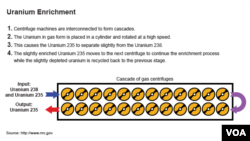Negotiations over Iran's nuclear program aim to build on an April agreement targeting the infrastructure needed to produce plutonium and enriched uranium, key components of nuclear weapons.
To understand what those elements are and why they matter, start with a look inside an atomic bomb. Stray bits of atom -- called neutrons -- collide with uranium or plutonium in the bomb's core, splitting the atoms apart and releasing enormous amounts of energy.
But not just any uranium will do.
Creating bomb-grade uranium
The radioactive element comes in two main forms, or isotopes: U235 and U238. Only U235 will split. But this isotope makes up less than 1 percent of the uranium mined from the ground.
So the uranium has to be purified, or enriched. That is where the centrifuges come in.
First, uranium is turned into a gas. That gas is fed into a centrifuge, a machine that spins at extremely high speed, separating the heavier U238 from lighter U235.
But they only separate a little. So the slightly enriched U235 goes into another centrifuge to separate a little more. Then another, and another. How many times depends on what it is for.
“If you enrich it to around three or four percent in the isotope uranium 235, you can use that to provide fuel for a nuclear power reactor,” said former nuclear negotiator Robert Einhorn at the Brookings Institution. “But if you enrich it to about 90 percent, then you can use it to build a nuclear bomb.”
In April, Iran agreed to a limit of about 6,000 centrifuges, and would only enrich uranium to under five percent. The country would maintain a stockpile of no more than 300 kilograms of this “low-enriched” uranium.
The agreement also limited research on improved centrifuge designs, according to Barry Blechman, co-founder of the Stimson Center, a Washington research institute.
“You want to make sure they do not develop more advanced centrifuges, because the ones they have working now are kind-of the Model T version and it is very slow,” Blechman said.
Plutonium
The April agreement also covered Iran’s ability to produce plutonium, the other bomb-making material.
It required the redesign of a plant fueled by natural, instead of enriched, uranium.
Natural uranium is composed of more than 99 percent U238. When a neutron strikes this form of uranium, the atom absorbs it and transforms into plutonium.
This “heavy-water” reactor can produce radioactive chemicals used to treat cancer. When the redesign is completed, it will still make those chemicals, but will produce much less plutonium.
The plutonium formed in the reactor core must still be separated from the rest of the fuel. Iran says it will ship spent fuel out of the country instead, eliminating its ability to collect bomb material.








